Business Law: Consumer Rights, Credit, and Competition Analysis
VerifiedAdded on 2020/01/28
|12
|3859
|466
Report
AI Summary
This comprehensive business law report delves into several critical areas of legal practice relevant to businesses. It begins by examining the Consumer Rights Act 2015 and the Sale of Goods Act, analyzing implied terms, transfer of property, and remedies for breach of contract, including product liability. The report then explores consumer credit agreements, including credit cards, bank loans, and hire purchase, along with the rights and obligations of debtors and creditors. Furthermore, it covers agency law, outlining different types of agents and their fiduciary duties. Finally, the report addresses competition law, detailing relevant legislation like the Competition Act 1998 and the role of the Competition and Markets Authority (CMA) in regulating anti-competitive practices. The report utilizes case studies and legal principles to provide a thorough overview of these interconnected areas of business law.
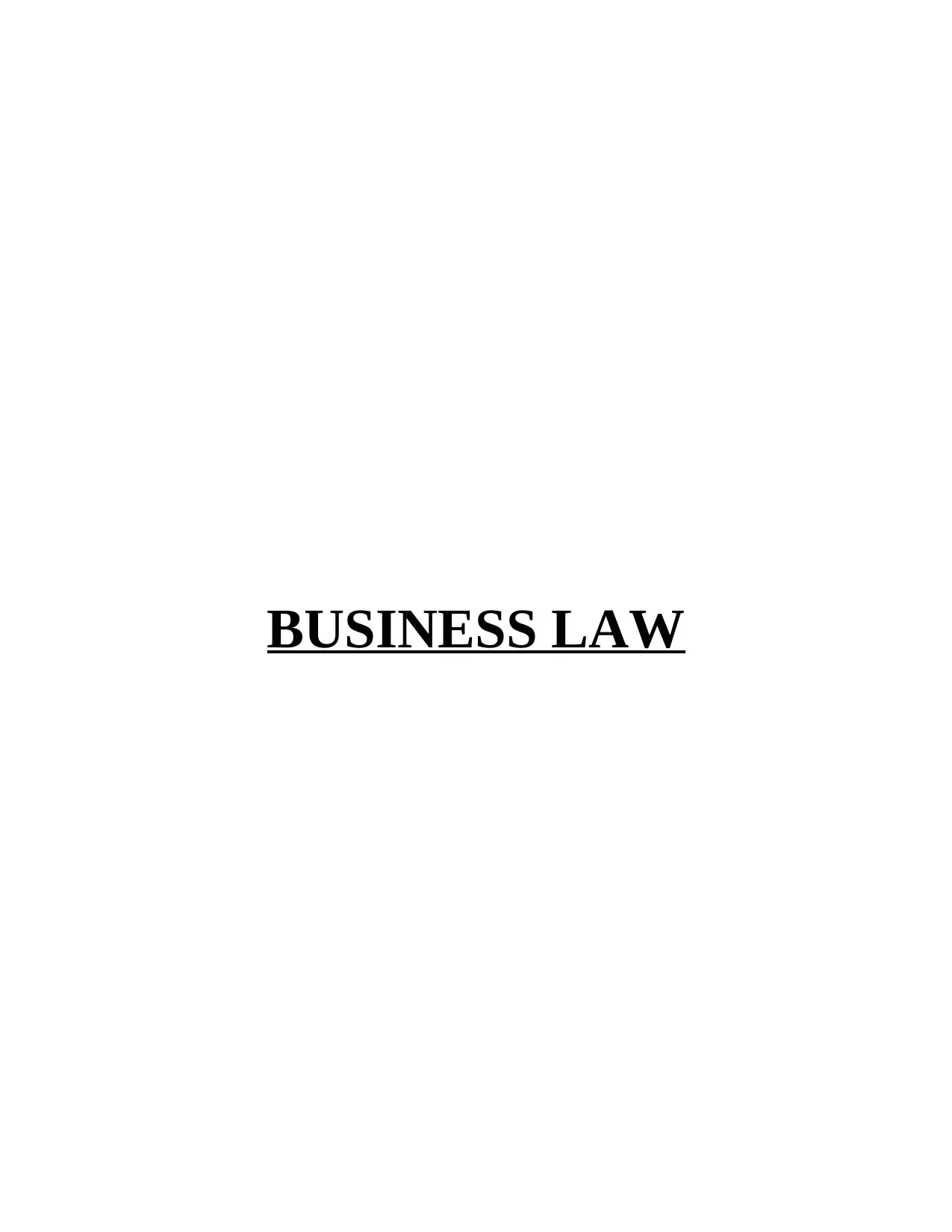
BUSINESS LAW
Paraphrase This Document
Need a fresh take? Get an instant paraphrase of this document with our AI Paraphraser
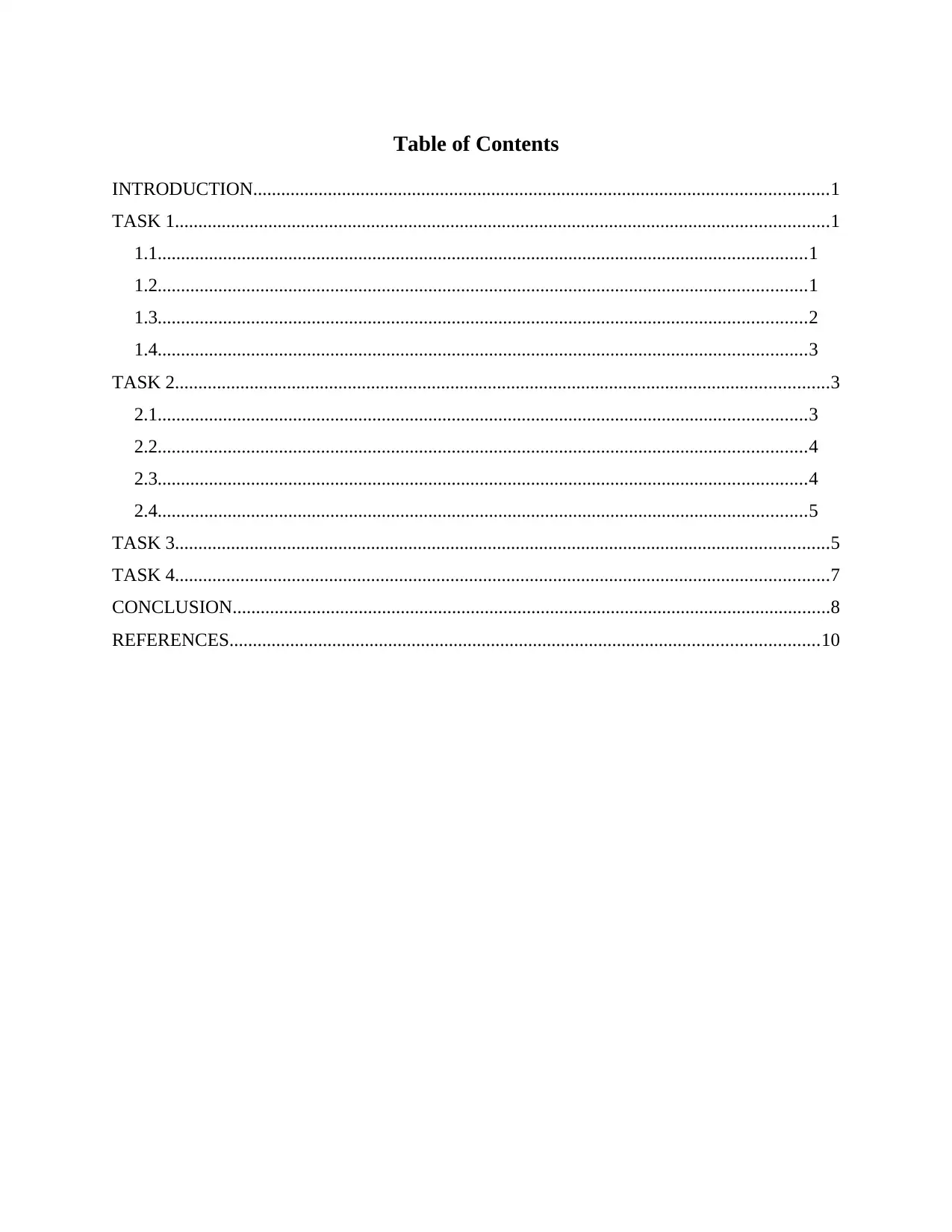
Table of Contents
INTRODUCTION...........................................................................................................................1
TASK 1............................................................................................................................................1
1.1...........................................................................................................................................1
1.2...........................................................................................................................................1
1.3...........................................................................................................................................2
1.4...........................................................................................................................................3
TASK 2............................................................................................................................................3
2.1...........................................................................................................................................3
2.2...........................................................................................................................................4
2.3...........................................................................................................................................4
2.4...........................................................................................................................................5
TASK 3............................................................................................................................................5
TASK 4............................................................................................................................................7
CONCLUSION................................................................................................................................8
REFERENCES..............................................................................................................................10
INTRODUCTION...........................................................................................................................1
TASK 1............................................................................................................................................1
1.1...........................................................................................................................................1
1.2...........................................................................................................................................1
1.3...........................................................................................................................................2
1.4...........................................................................................................................................3
TASK 2............................................................................................................................................3
2.1...........................................................................................................................................3
2.2...........................................................................................................................................4
2.3...........................................................................................................................................4
2.4...........................................................................................................................................5
TASK 3............................................................................................................................................5
TASK 4............................................................................................................................................7
CONCLUSION................................................................................................................................8
REFERENCES..............................................................................................................................10
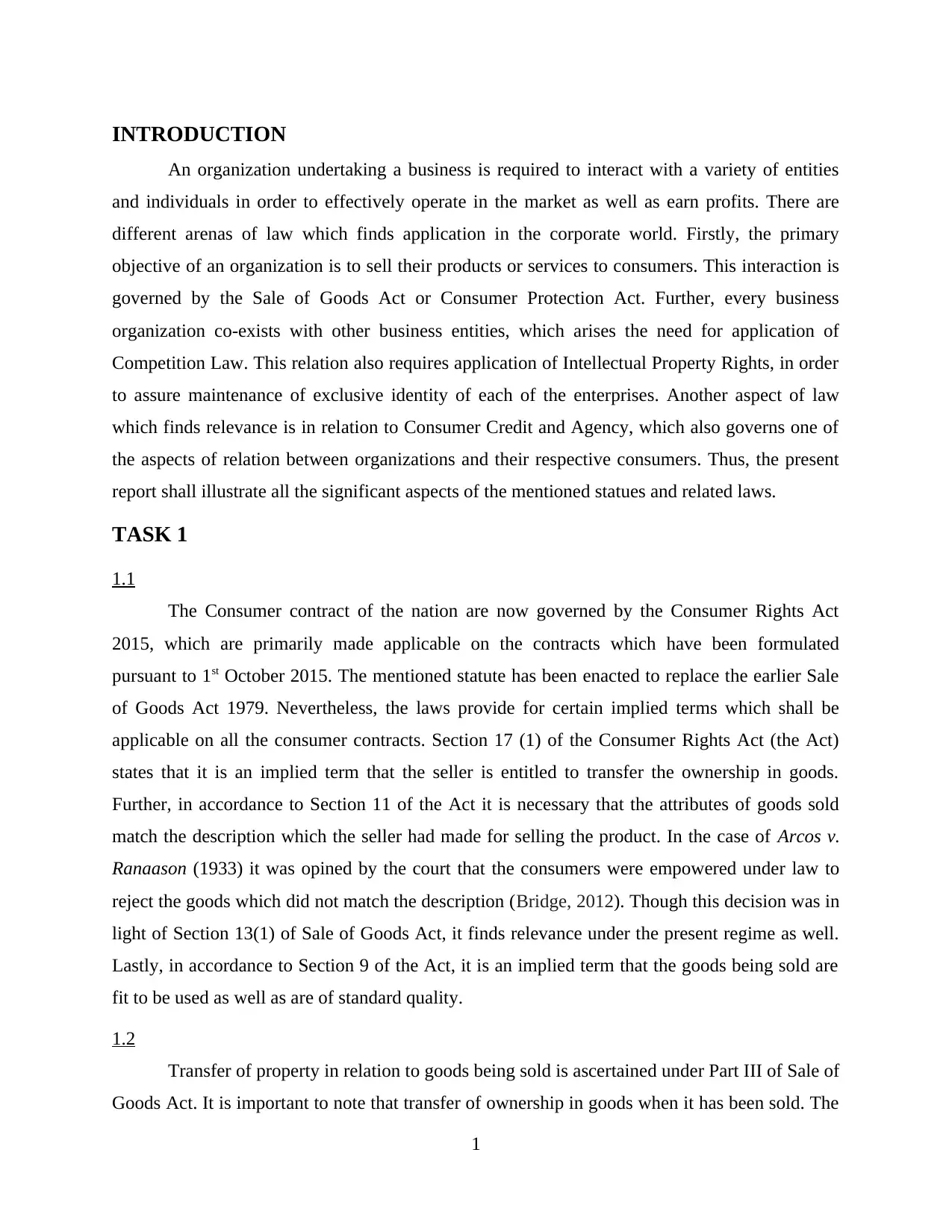
INTRODUCTION
An organization undertaking a business is required to interact with a variety of entities
and individuals in order to effectively operate in the market as well as earn profits. There are
different arenas of law which finds application in the corporate world. Firstly, the primary
objective of an organization is to sell their products or services to consumers. This interaction is
governed by the Sale of Goods Act or Consumer Protection Act. Further, every business
organization co-exists with other business entities, which arises the need for application of
Competition Law. This relation also requires application of Intellectual Property Rights, in order
to assure maintenance of exclusive identity of each of the enterprises. Another aspect of law
which finds relevance is in relation to Consumer Credit and Agency, which also governs one of
the aspects of relation between organizations and their respective consumers. Thus, the present
report shall illustrate all the significant aspects of the mentioned statues and related laws.
TASK 1
1.1
The Consumer contract of the nation are now governed by the Consumer Rights Act
2015, which are primarily made applicable on the contracts which have been formulated
pursuant to 1st October 2015. The mentioned statute has been enacted to replace the earlier Sale
of Goods Act 1979. Nevertheless, the laws provide for certain implied terms which shall be
applicable on all the consumer contracts. Section 17 (1) of the Consumer Rights Act (the Act)
states that it is an implied term that the seller is entitled to transfer the ownership in goods.
Further, in accordance to Section 11 of the Act it is necessary that the attributes of goods sold
match the description which the seller had made for selling the product. In the case of Arcos v.
Ranaason (1933) it was opined by the court that the consumers were empowered under law to
reject the goods which did not match the description (Bridge, 2012). Though this decision was in
light of Section 13(1) of Sale of Goods Act, it finds relevance under the present regime as well.
Lastly, in accordance to Section 9 of the Act, it is an implied term that the goods being sold are
fit to be used as well as are of standard quality.
1.2
Transfer of property in relation to goods being sold is ascertained under Part III of Sale of
Goods Act. It is important to note that transfer of ownership in goods when it has been sold. The
1
An organization undertaking a business is required to interact with a variety of entities
and individuals in order to effectively operate in the market as well as earn profits. There are
different arenas of law which finds application in the corporate world. Firstly, the primary
objective of an organization is to sell their products or services to consumers. This interaction is
governed by the Sale of Goods Act or Consumer Protection Act. Further, every business
organization co-exists with other business entities, which arises the need for application of
Competition Law. This relation also requires application of Intellectual Property Rights, in order
to assure maintenance of exclusive identity of each of the enterprises. Another aspect of law
which finds relevance is in relation to Consumer Credit and Agency, which also governs one of
the aspects of relation between organizations and their respective consumers. Thus, the present
report shall illustrate all the significant aspects of the mentioned statues and related laws.
TASK 1
1.1
The Consumer contract of the nation are now governed by the Consumer Rights Act
2015, which are primarily made applicable on the contracts which have been formulated
pursuant to 1st October 2015. The mentioned statute has been enacted to replace the earlier Sale
of Goods Act 1979. Nevertheless, the laws provide for certain implied terms which shall be
applicable on all the consumer contracts. Section 17 (1) of the Consumer Rights Act (the Act)
states that it is an implied term that the seller is entitled to transfer the ownership in goods.
Further, in accordance to Section 11 of the Act it is necessary that the attributes of goods sold
match the description which the seller had made for selling the product. In the case of Arcos v.
Ranaason (1933) it was opined by the court that the consumers were empowered under law to
reject the goods which did not match the description (Bridge, 2012). Though this decision was in
light of Section 13(1) of Sale of Goods Act, it finds relevance under the present regime as well.
Lastly, in accordance to Section 9 of the Act, it is an implied term that the goods being sold are
fit to be used as well as are of standard quality.
1.2
Transfer of property in relation to goods being sold is ascertained under Part III of Sale of
Goods Act. It is important to note that transfer of ownership in goods when it has been sold. The
1
⊘ This is a preview!⊘
Do you want full access?
Subscribe today to unlock all pages.

Trusted by 1+ million students worldwide
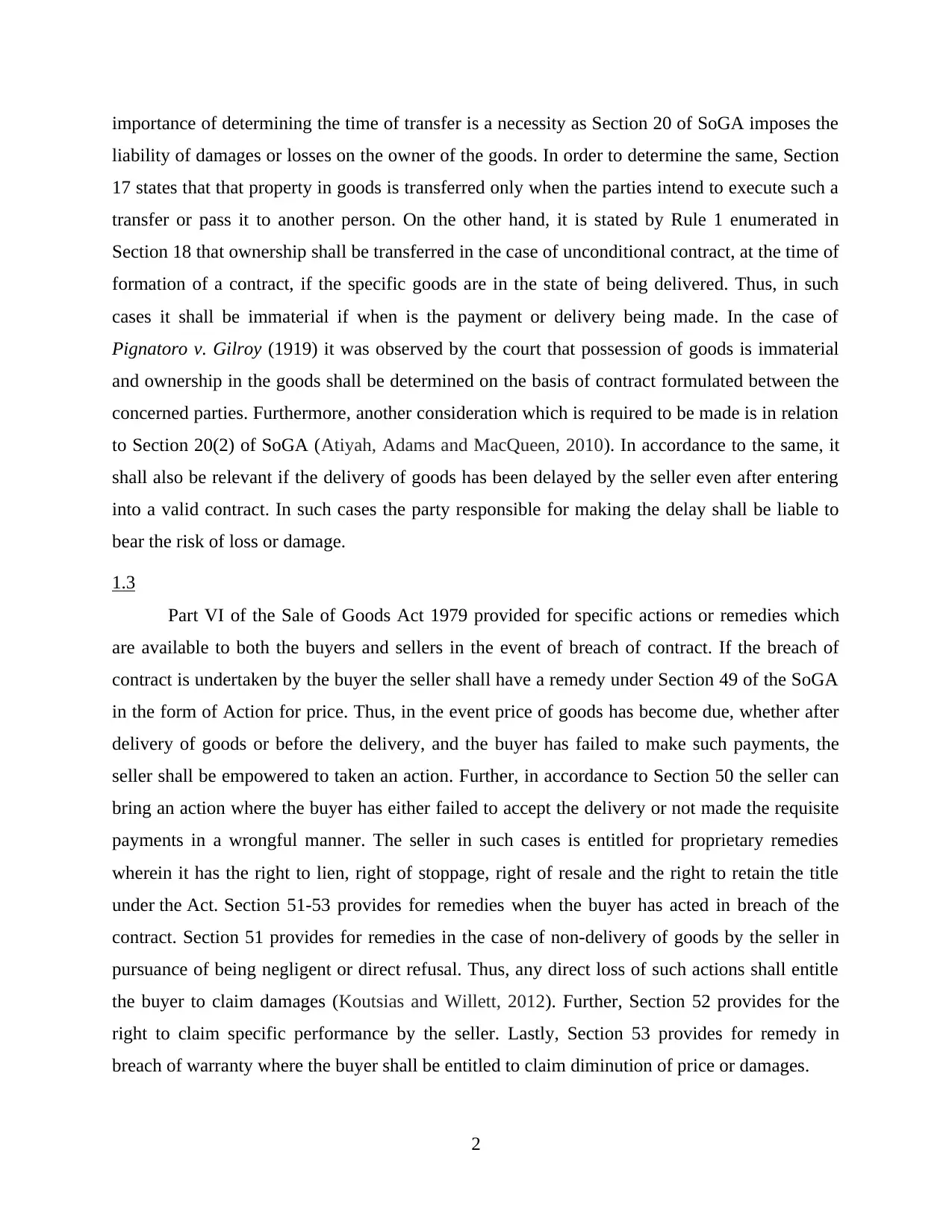
importance of determining the time of transfer is a necessity as Section 20 of SoGA imposes the
liability of damages or losses on the owner of the goods. In order to determine the same, Section
17 states that that property in goods is transferred only when the parties intend to execute such a
transfer or pass it to another person. On the other hand, it is stated by Rule 1 enumerated in
Section 18 that ownership shall be transferred in the case of unconditional contract, at the time of
formation of a contract, if the specific goods are in the state of being delivered. Thus, in such
cases it shall be immaterial if when is the payment or delivery being made. In the case of
Pignatoro v. Gilroy (1919) it was observed by the court that possession of goods is immaterial
and ownership in the goods shall be determined on the basis of contract formulated between the
concerned parties. Furthermore, another consideration which is required to be made is in relation
to Section 20(2) of SoGA (Atiyah, Adams and MacQueen, 2010). In accordance to the same, it
shall also be relevant if the delivery of goods has been delayed by the seller even after entering
into a valid contract. In such cases the party responsible for making the delay shall be liable to
bear the risk of loss or damage.
1.3
Part VI of the Sale of Goods Act 1979 provided for specific actions or remedies which
are available to both the buyers and sellers in the event of breach of contract. If the breach of
contract is undertaken by the buyer the seller shall have a remedy under Section 49 of the SoGA
in the form of Action for price. Thus, in the event price of goods has become due, whether after
delivery of goods or before the delivery, and the buyer has failed to make such payments, the
seller shall be empowered to taken an action. Further, in accordance to Section 50 the seller can
bring an action where the buyer has either failed to accept the delivery or not made the requisite
payments in a wrongful manner. The seller in such cases is entitled for proprietary remedies
wherein it has the right to lien, right of stoppage, right of resale and the right to retain the title
under the Act. Section 51-53 provides for remedies when the buyer has acted in breach of the
contract. Section 51 provides for remedies in the case of non-delivery of goods by the seller in
pursuance of being negligent or direct refusal. Thus, any direct loss of such actions shall entitle
the buyer to claim damages (Koutsias and Willett, 2012). Further, Section 52 provides for the
right to claim specific performance by the seller. Lastly, Section 53 provides for remedy in
breach of warranty where the buyer shall be entitled to claim diminution of price or damages.
2
liability of damages or losses on the owner of the goods. In order to determine the same, Section
17 states that that property in goods is transferred only when the parties intend to execute such a
transfer or pass it to another person. On the other hand, it is stated by Rule 1 enumerated in
Section 18 that ownership shall be transferred in the case of unconditional contract, at the time of
formation of a contract, if the specific goods are in the state of being delivered. Thus, in such
cases it shall be immaterial if when is the payment or delivery being made. In the case of
Pignatoro v. Gilroy (1919) it was observed by the court that possession of goods is immaterial
and ownership in the goods shall be determined on the basis of contract formulated between the
concerned parties. Furthermore, another consideration which is required to be made is in relation
to Section 20(2) of SoGA (Atiyah, Adams and MacQueen, 2010). In accordance to the same, it
shall also be relevant if the delivery of goods has been delayed by the seller even after entering
into a valid contract. In such cases the party responsible for making the delay shall be liable to
bear the risk of loss or damage.
1.3
Part VI of the Sale of Goods Act 1979 provided for specific actions or remedies which
are available to both the buyers and sellers in the event of breach of contract. If the breach of
contract is undertaken by the buyer the seller shall have a remedy under Section 49 of the SoGA
in the form of Action for price. Thus, in the event price of goods has become due, whether after
delivery of goods or before the delivery, and the buyer has failed to make such payments, the
seller shall be empowered to taken an action. Further, in accordance to Section 50 the seller can
bring an action where the buyer has either failed to accept the delivery or not made the requisite
payments in a wrongful manner. The seller in such cases is entitled for proprietary remedies
wherein it has the right to lien, right of stoppage, right of resale and the right to retain the title
under the Act. Section 51-53 provides for remedies when the buyer has acted in breach of the
contract. Section 51 provides for remedies in the case of non-delivery of goods by the seller in
pursuance of being negligent or direct refusal. Thus, any direct loss of such actions shall entitle
the buyer to claim damages (Koutsias and Willett, 2012). Further, Section 52 provides for the
right to claim specific performance by the seller. Lastly, Section 53 provides for remedy in
breach of warranty where the buyer shall be entitled to claim diminution of price or damages.
2
Paraphrase This Document
Need a fresh take? Get an instant paraphrase of this document with our AI Paraphraser
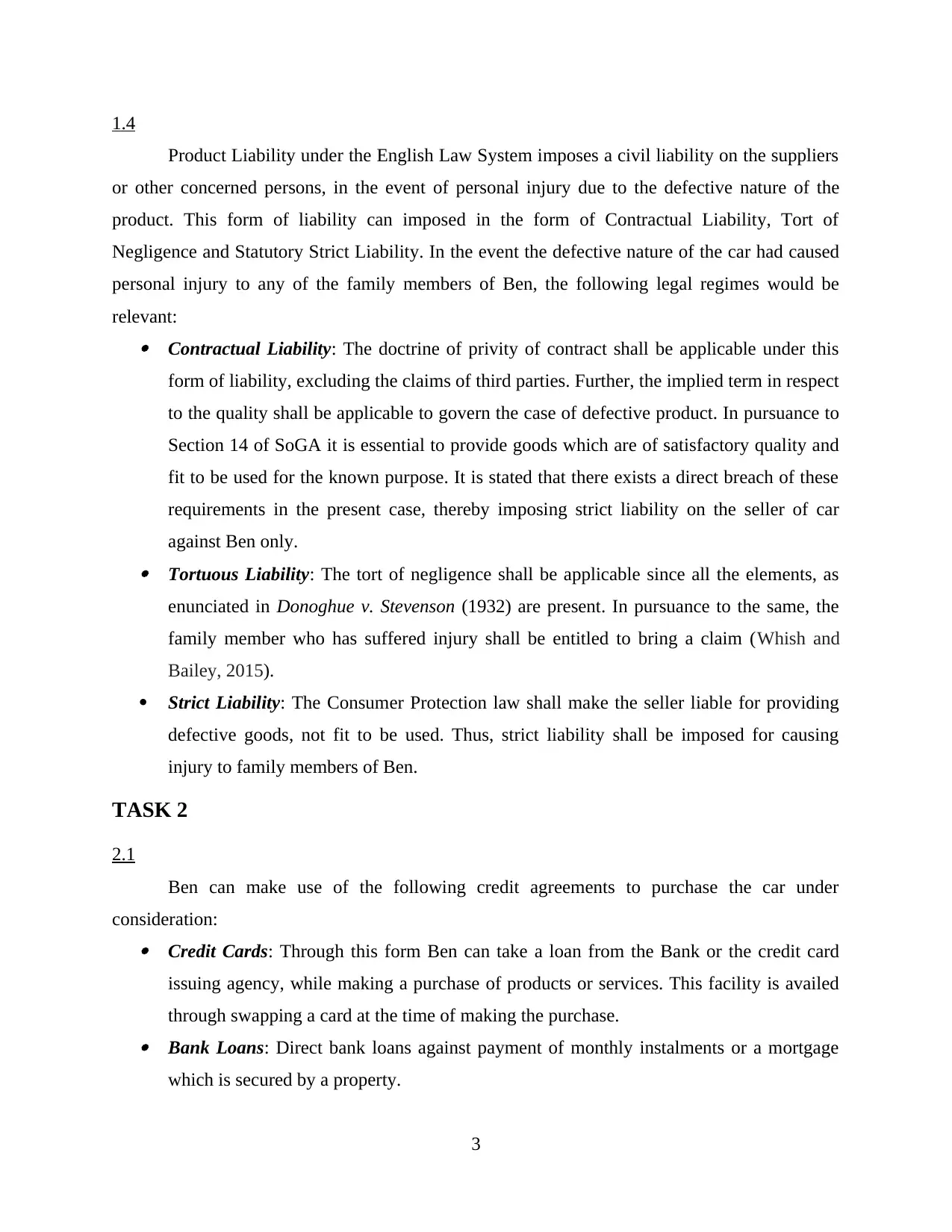
1.4
Product Liability under the English Law System imposes a civil liability on the suppliers
or other concerned persons, in the event of personal injury due to the defective nature of the
product. This form of liability can imposed in the form of Contractual Liability, Tort of
Negligence and Statutory Strict Liability. In the event the defective nature of the car had caused
personal injury to any of the family members of Ben, the following legal regimes would be
relevant: Contractual Liability: The doctrine of privity of contract shall be applicable under this
form of liability, excluding the claims of third parties. Further, the implied term in respect
to the quality shall be applicable to govern the case of defective product. In pursuance to
Section 14 of SoGA it is essential to provide goods which are of satisfactory quality and
fit to be used for the known purpose. It is stated that there exists a direct breach of these
requirements in the present case, thereby imposing strict liability on the seller of car
against Ben only. Tortuous Liability: The tort of negligence shall be applicable since all the elements, as
enunciated in Donoghue v. Stevenson (1932) are present. In pursuance to the same, the
family member who has suffered injury shall be entitled to bring a claim (Whish and
Bailey, 2015).
Strict Liability: The Consumer Protection law shall make the seller liable for providing
defective goods, not fit to be used. Thus, strict liability shall be imposed for causing
injury to family members of Ben.
TASK 2
2.1
Ben can make use of the following credit agreements to purchase the car under
consideration: Credit Cards: Through this form Ben can take a loan from the Bank or the credit card
issuing agency, while making a purchase of products or services. This facility is availed
through swapping a card at the time of making the purchase. Bank Loans: Direct bank loans against payment of monthly instalments or a mortgage
which is secured by a property.
3
Product Liability under the English Law System imposes a civil liability on the suppliers
or other concerned persons, in the event of personal injury due to the defective nature of the
product. This form of liability can imposed in the form of Contractual Liability, Tort of
Negligence and Statutory Strict Liability. In the event the defective nature of the car had caused
personal injury to any of the family members of Ben, the following legal regimes would be
relevant: Contractual Liability: The doctrine of privity of contract shall be applicable under this
form of liability, excluding the claims of third parties. Further, the implied term in respect
to the quality shall be applicable to govern the case of defective product. In pursuance to
Section 14 of SoGA it is essential to provide goods which are of satisfactory quality and
fit to be used for the known purpose. It is stated that there exists a direct breach of these
requirements in the present case, thereby imposing strict liability on the seller of car
against Ben only. Tortuous Liability: The tort of negligence shall be applicable since all the elements, as
enunciated in Donoghue v. Stevenson (1932) are present. In pursuance to the same, the
family member who has suffered injury shall be entitled to bring a claim (Whish and
Bailey, 2015).
Strict Liability: The Consumer Protection law shall make the seller liable for providing
defective goods, not fit to be used. Thus, strict liability shall be imposed for causing
injury to family members of Ben.
TASK 2
2.1
Ben can make use of the following credit agreements to purchase the car under
consideration: Credit Cards: Through this form Ben can take a loan from the Bank or the credit card
issuing agency, while making a purchase of products or services. This facility is availed
through swapping a card at the time of making the purchase. Bank Loans: Direct bank loans against payment of monthly instalments or a mortgage
which is secured by a property.
3
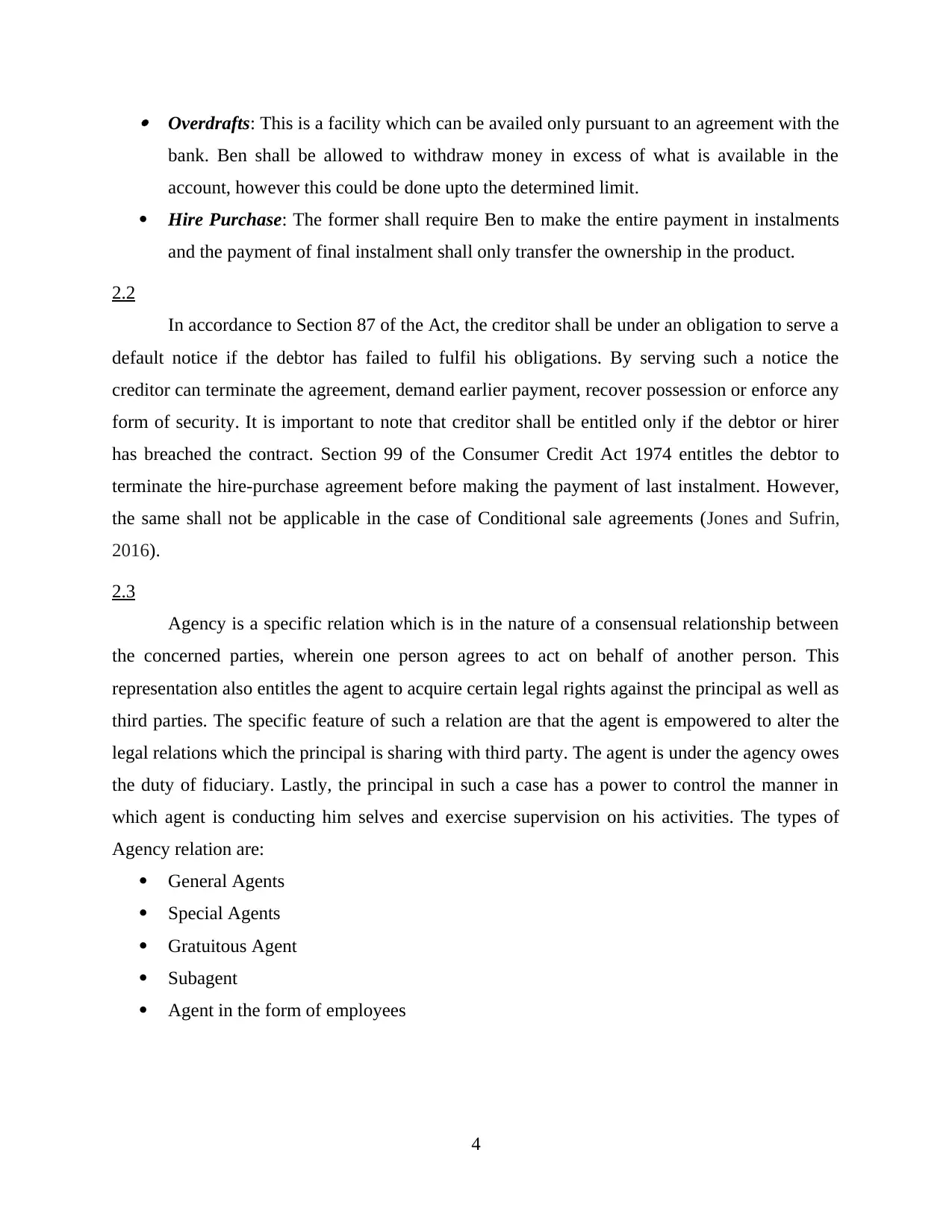
Overdrafts: This is a facility which can be availed only pursuant to an agreement with the
bank. Ben shall be allowed to withdraw money in excess of what is available in the
account, however this could be done upto the determined limit.
Hire Purchase: The former shall require Ben to make the entire payment in instalments
and the payment of final instalment shall only transfer the ownership in the product.
2.2
In accordance to Section 87 of the Act, the creditor shall be under an obligation to serve a
default notice if the debtor has failed to fulfil his obligations. By serving such a notice the
creditor can terminate the agreement, demand earlier payment, recover possession or enforce any
form of security. It is important to note that creditor shall be entitled only if the debtor or hirer
has breached the contract. Section 99 of the Consumer Credit Act 1974 entitles the debtor to
terminate the hire-purchase agreement before making the payment of last instalment. However,
the same shall not be applicable in the case of Conditional sale agreements (Jones and Sufrin,
2016).
2.3
Agency is a specific relation which is in the nature of a consensual relationship between
the concerned parties, wherein one person agrees to act on behalf of another person. This
representation also entitles the agent to acquire certain legal rights against the principal as well as
third parties. The specific feature of such a relation are that the agent is empowered to alter the
legal relations which the principal is sharing with third party. The agent is under the agency owes
the duty of fiduciary. Lastly, the principal in such a case has a power to control the manner in
which agent is conducting him selves and exercise supervision on his activities. The types of
Agency relation are:
General Agents
Special Agents
Gratuitous Agent
Subagent
Agent in the form of employees
4
bank. Ben shall be allowed to withdraw money in excess of what is available in the
account, however this could be done upto the determined limit.
Hire Purchase: The former shall require Ben to make the entire payment in instalments
and the payment of final instalment shall only transfer the ownership in the product.
2.2
In accordance to Section 87 of the Act, the creditor shall be under an obligation to serve a
default notice if the debtor has failed to fulfil his obligations. By serving such a notice the
creditor can terminate the agreement, demand earlier payment, recover possession or enforce any
form of security. It is important to note that creditor shall be entitled only if the debtor or hirer
has breached the contract. Section 99 of the Consumer Credit Act 1974 entitles the debtor to
terminate the hire-purchase agreement before making the payment of last instalment. However,
the same shall not be applicable in the case of Conditional sale agreements (Jones and Sufrin,
2016).
2.3
Agency is a specific relation which is in the nature of a consensual relationship between
the concerned parties, wherein one person agrees to act on behalf of another person. This
representation also entitles the agent to acquire certain legal rights against the principal as well as
third parties. The specific feature of such a relation are that the agent is empowered to alter the
legal relations which the principal is sharing with third party. The agent is under the agency owes
the duty of fiduciary. Lastly, the principal in such a case has a power to control the manner in
which agent is conducting him selves and exercise supervision on his activities. The types of
Agency relation are:
General Agents
Special Agents
Gratuitous Agent
Subagent
Agent in the form of employees
4
⊘ This is a preview!⊘
Do you want full access?
Subscribe today to unlock all pages.

Trusted by 1+ million students worldwide
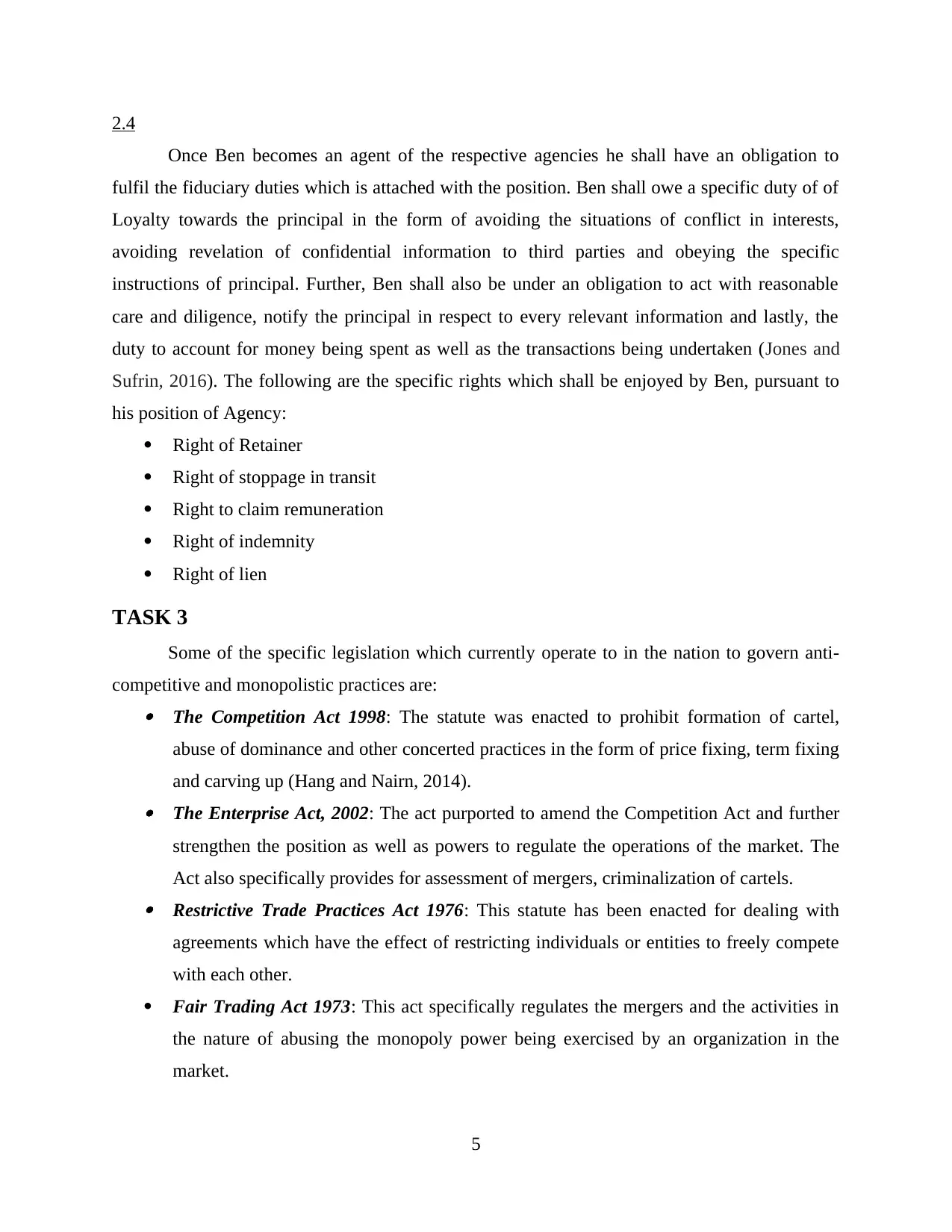
2.4
Once Ben becomes an agent of the respective agencies he shall have an obligation to
fulfil the fiduciary duties which is attached with the position. Ben shall owe a specific duty of of
Loyalty towards the principal in the form of avoiding the situations of conflict in interests,
avoiding revelation of confidential information to third parties and obeying the specific
instructions of principal. Further, Ben shall also be under an obligation to act with reasonable
care and diligence, notify the principal in respect to every relevant information and lastly, the
duty to account for money being spent as well as the transactions being undertaken (Jones and
Sufrin, 2016). The following are the specific rights which shall be enjoyed by Ben, pursuant to
his position of Agency:
Right of Retainer
Right of stoppage in transit
Right to claim remuneration
Right of indemnity
Right of lien
TASK 3
Some of the specific legislation which currently operate to in the nation to govern anti-
competitive and monopolistic practices are: The Competition Act 1998: The statute was enacted to prohibit formation of cartel,
abuse of dominance and other concerted practices in the form of price fixing, term fixing
and carving up (Hang and Nairn, 2014). The Enterprise Act, 2002: The act purported to amend the Competition Act and further
strengthen the position as well as powers to regulate the operations of the market. The
Act also specifically provides for assessment of mergers, criminalization of cartels. Restrictive Trade Practices Act 1976: This statute has been enacted for dealing with
agreements which have the effect of restricting individuals or entities to freely compete
with each other.
Fair Trading Act 1973: This act specifically regulates the mergers and the activities in
the nature of abusing the monopoly power being exercised by an organization in the
market.
5
Once Ben becomes an agent of the respective agencies he shall have an obligation to
fulfil the fiduciary duties which is attached with the position. Ben shall owe a specific duty of of
Loyalty towards the principal in the form of avoiding the situations of conflict in interests,
avoiding revelation of confidential information to third parties and obeying the specific
instructions of principal. Further, Ben shall also be under an obligation to act with reasonable
care and diligence, notify the principal in respect to every relevant information and lastly, the
duty to account for money being spent as well as the transactions being undertaken (Jones and
Sufrin, 2016). The following are the specific rights which shall be enjoyed by Ben, pursuant to
his position of Agency:
Right of Retainer
Right of stoppage in transit
Right to claim remuneration
Right of indemnity
Right of lien
TASK 3
Some of the specific legislation which currently operate to in the nation to govern anti-
competitive and monopolistic practices are: The Competition Act 1998: The statute was enacted to prohibit formation of cartel,
abuse of dominance and other concerted practices in the form of price fixing, term fixing
and carving up (Hang and Nairn, 2014). The Enterprise Act, 2002: The act purported to amend the Competition Act and further
strengthen the position as well as powers to regulate the operations of the market. The
Act also specifically provides for assessment of mergers, criminalization of cartels. Restrictive Trade Practices Act 1976: This statute has been enacted for dealing with
agreements which have the effect of restricting individuals or entities to freely compete
with each other.
Fair Trading Act 1973: This act specifically regulates the mergers and the activities in
the nature of abusing the monopoly power being exercised by an organization in the
market.
5
Paraphrase This Document
Need a fresh take? Get an instant paraphrase of this document with our AI Paraphraser
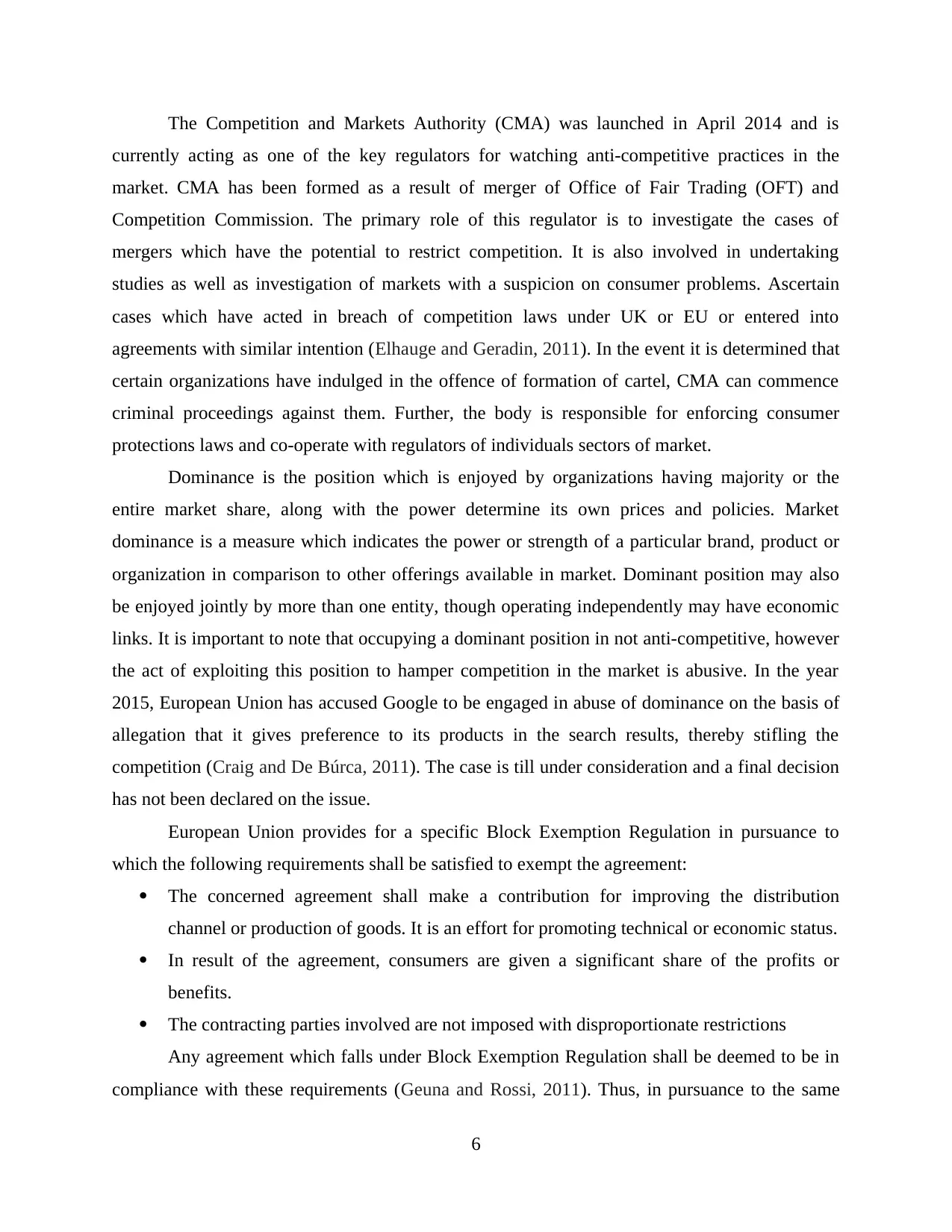
The Competition and Markets Authority (CMA) was launched in April 2014 and is
currently acting as one of the key regulators for watching anti-competitive practices in the
market. CMA has been formed as a result of merger of Office of Fair Trading (OFT) and
Competition Commission. The primary role of this regulator is to investigate the cases of
mergers which have the potential to restrict competition. It is also involved in undertaking
studies as well as investigation of markets with a suspicion on consumer problems. Ascertain
cases which have acted in breach of competition laws under UK or EU or entered into
agreements with similar intention (Elhauge and Geradin, 2011). In the event it is determined that
certain organizations have indulged in the offence of formation of cartel, CMA can commence
criminal proceedings against them. Further, the body is responsible for enforcing consumer
protections laws and co-operate with regulators of individuals sectors of market.
Dominance is the position which is enjoyed by organizations having majority or the
entire market share, along with the power determine its own prices and policies. Market
dominance is a measure which indicates the power or strength of a particular brand, product or
organization in comparison to other offerings available in market. Dominant position may also
be enjoyed jointly by more than one entity, though operating independently may have economic
links. It is important to note that occupying a dominant position in not anti-competitive, however
the act of exploiting this position to hamper competition in the market is abusive. In the year
2015, European Union has accused Google to be engaged in abuse of dominance on the basis of
allegation that it gives preference to its products in the search results, thereby stifling the
competition (Craig and De Búrca, 2011). The case is till under consideration and a final decision
has not been declared on the issue.
European Union provides for a specific Block Exemption Regulation in pursuance to
which the following requirements shall be satisfied to exempt the agreement:
The concerned agreement shall make a contribution for improving the distribution
channel or production of goods. It is an effort for promoting technical or economic status.
In result of the agreement, consumers are given a significant share of the profits or
benefits.
The contracting parties involved are not imposed with disproportionate restrictions
Any agreement which falls under Block Exemption Regulation shall be deemed to be in
compliance with these requirements (Geuna and Rossi, 2011). Thus, in pursuance to the same
6
currently acting as one of the key regulators for watching anti-competitive practices in the
market. CMA has been formed as a result of merger of Office of Fair Trading (OFT) and
Competition Commission. The primary role of this regulator is to investigate the cases of
mergers which have the potential to restrict competition. It is also involved in undertaking
studies as well as investigation of markets with a suspicion on consumer problems. Ascertain
cases which have acted in breach of competition laws under UK or EU or entered into
agreements with similar intention (Elhauge and Geradin, 2011). In the event it is determined that
certain organizations have indulged in the offence of formation of cartel, CMA can commence
criminal proceedings against them. Further, the body is responsible for enforcing consumer
protections laws and co-operate with regulators of individuals sectors of market.
Dominance is the position which is enjoyed by organizations having majority or the
entire market share, along with the power determine its own prices and policies. Market
dominance is a measure which indicates the power or strength of a particular brand, product or
organization in comparison to other offerings available in market. Dominant position may also
be enjoyed jointly by more than one entity, though operating independently may have economic
links. It is important to note that occupying a dominant position in not anti-competitive, however
the act of exploiting this position to hamper competition in the market is abusive. In the year
2015, European Union has accused Google to be engaged in abuse of dominance on the basis of
allegation that it gives preference to its products in the search results, thereby stifling the
competition (Craig and De Búrca, 2011). The case is till under consideration and a final decision
has not been declared on the issue.
European Union provides for a specific Block Exemption Regulation in pursuance to
which the following requirements shall be satisfied to exempt the agreement:
The concerned agreement shall make a contribution for improving the distribution
channel or production of goods. It is an effort for promoting technical or economic status.
In result of the agreement, consumers are given a significant share of the profits or
benefits.
The contracting parties involved are not imposed with disproportionate restrictions
Any agreement which falls under Block Exemption Regulation shall be deemed to be in
compliance with these requirements (Geuna and Rossi, 2011). Thus, in pursuance to the same
6
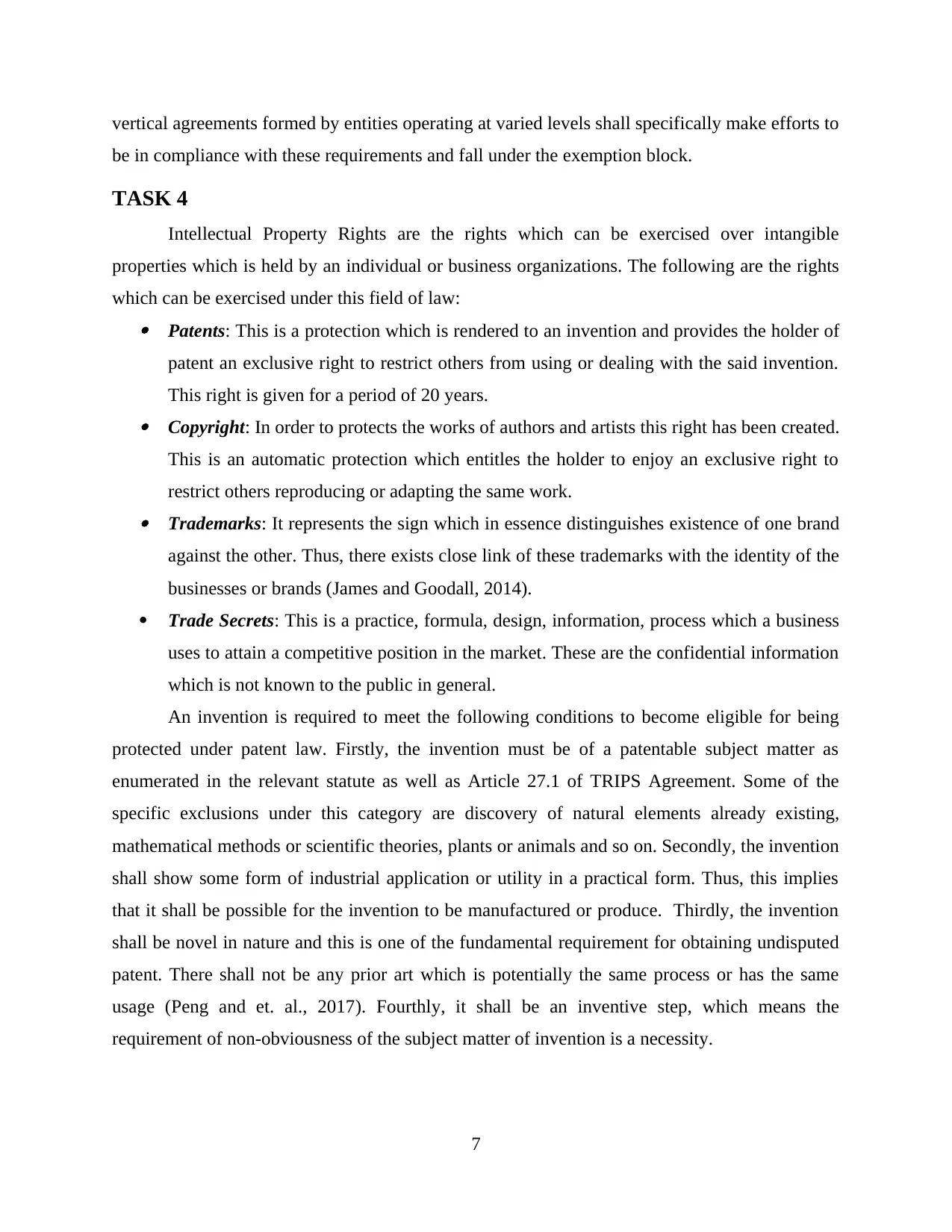
vertical agreements formed by entities operating at varied levels shall specifically make efforts to
be in compliance with these requirements and fall under the exemption block.
TASK 4
Intellectual Property Rights are the rights which can be exercised over intangible
properties which is held by an individual or business organizations. The following are the rights
which can be exercised under this field of law: Patents: This is a protection which is rendered to an invention and provides the holder of
patent an exclusive right to restrict others from using or dealing with the said invention.
This right is given for a period of 20 years. Copyright: In order to protects the works of authors and artists this right has been created.
This is an automatic protection which entitles the holder to enjoy an exclusive right to
restrict others reproducing or adapting the same work. Trademarks: It represents the sign which in essence distinguishes existence of one brand
against the other. Thus, there exists close link of these trademarks with the identity of the
businesses or brands (James and Goodall, 2014).
Trade Secrets: This is a practice, formula, design, information, process which a business
uses to attain a competitive position in the market. These are the confidential information
which is not known to the public in general.
An invention is required to meet the following conditions to become eligible for being
protected under patent law. Firstly, the invention must be of a patentable subject matter as
enumerated in the relevant statute as well as Article 27.1 of TRIPS Agreement. Some of the
specific exclusions under this category are discovery of natural elements already existing,
mathematical methods or scientific theories, plants or animals and so on. Secondly, the invention
shall show some form of industrial application or utility in a practical form. Thus, this implies
that it shall be possible for the invention to be manufactured or produce. Thirdly, the invention
shall be novel in nature and this is one of the fundamental requirement for obtaining undisputed
patent. There shall not be any prior art which is potentially the same process or has the same
usage (Peng and et. al., 2017). Fourthly, it shall be an inventive step, which means the
requirement of non-obviousness of the subject matter of invention is a necessity.
7
be in compliance with these requirements and fall under the exemption block.
TASK 4
Intellectual Property Rights are the rights which can be exercised over intangible
properties which is held by an individual or business organizations. The following are the rights
which can be exercised under this field of law: Patents: This is a protection which is rendered to an invention and provides the holder of
patent an exclusive right to restrict others from using or dealing with the said invention.
This right is given for a period of 20 years. Copyright: In order to protects the works of authors and artists this right has been created.
This is an automatic protection which entitles the holder to enjoy an exclusive right to
restrict others reproducing or adapting the same work. Trademarks: It represents the sign which in essence distinguishes existence of one brand
against the other. Thus, there exists close link of these trademarks with the identity of the
businesses or brands (James and Goodall, 2014).
Trade Secrets: This is a practice, formula, design, information, process which a business
uses to attain a competitive position in the market. These are the confidential information
which is not known to the public in general.
An invention is required to meet the following conditions to become eligible for being
protected under patent law. Firstly, the invention must be of a patentable subject matter as
enumerated in the relevant statute as well as Article 27.1 of TRIPS Agreement. Some of the
specific exclusions under this category are discovery of natural elements already existing,
mathematical methods or scientific theories, plants or animals and so on. Secondly, the invention
shall show some form of industrial application or utility in a practical form. Thus, this implies
that it shall be possible for the invention to be manufactured or produce. Thirdly, the invention
shall be novel in nature and this is one of the fundamental requirement for obtaining undisputed
patent. There shall not be any prior art which is potentially the same process or has the same
usage (Peng and et. al., 2017). Fourthly, it shall be an inventive step, which means the
requirement of non-obviousness of the subject matter of invention is a necessity.
7
⊘ This is a preview!⊘
Do you want full access?
Subscribe today to unlock all pages.

Trusted by 1+ million students worldwide
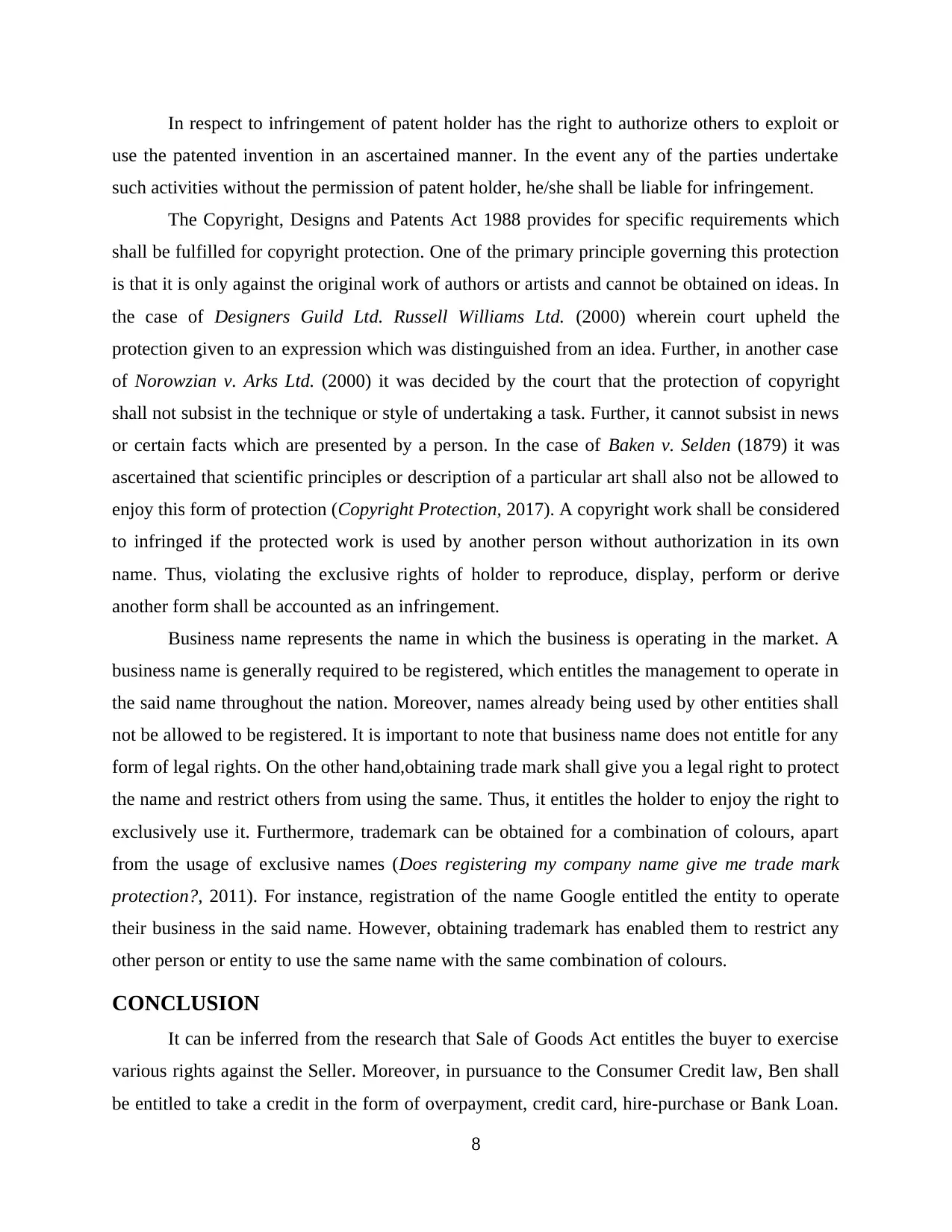
In respect to infringement of patent holder has the right to authorize others to exploit or
use the patented invention in an ascertained manner. In the event any of the parties undertake
such activities without the permission of patent holder, he/she shall be liable for infringement.
The Copyright, Designs and Patents Act 1988 provides for specific requirements which
shall be fulfilled for copyright protection. One of the primary principle governing this protection
is that it is only against the original work of authors or artists and cannot be obtained on ideas. In
the case of Designers Guild Ltd. Russell Williams Ltd. (2000) wherein court upheld the
protection given to an expression which was distinguished from an idea. Further, in another case
of Norowzian v. Arks Ltd. (2000) it was decided by the court that the protection of copyright
shall not subsist in the technique or style of undertaking a task. Further, it cannot subsist in news
or certain facts which are presented by a person. In the case of Baken v. Selden (1879) it was
ascertained that scientific principles or description of a particular art shall also not be allowed to
enjoy this form of protection (Copyright Protection, 2017). A copyright work shall be considered
to infringed if the protected work is used by another person without authorization in its own
name. Thus, violating the exclusive rights of holder to reproduce, display, perform or derive
another form shall be accounted as an infringement.
Business name represents the name in which the business is operating in the market. A
business name is generally required to be registered, which entitles the management to operate in
the said name throughout the nation. Moreover, names already being used by other entities shall
not be allowed to be registered. It is important to note that business name does not entitle for any
form of legal rights. On the other hand,obtaining trade mark shall give you a legal right to protect
the name and restrict others from using the same. Thus, it entitles the holder to enjoy the right to
exclusively use it. Furthermore, trademark can be obtained for a combination of colours, apart
from the usage of exclusive names (Does registering my company name give me trade mark
protection?, 2011). For instance, registration of the name Google entitled the entity to operate
their business in the said name. However, obtaining trademark has enabled them to restrict any
other person or entity to use the same name with the same combination of colours.
CONCLUSION
It can be inferred from the research that Sale of Goods Act entitles the buyer to exercise
various rights against the Seller. Moreover, in pursuance to the Consumer Credit law, Ben shall
be entitled to take a credit in the form of overpayment, credit card, hire-purchase or Bank Loan.
8
use the patented invention in an ascertained manner. In the event any of the parties undertake
such activities without the permission of patent holder, he/she shall be liable for infringement.
The Copyright, Designs and Patents Act 1988 provides for specific requirements which
shall be fulfilled for copyright protection. One of the primary principle governing this protection
is that it is only against the original work of authors or artists and cannot be obtained on ideas. In
the case of Designers Guild Ltd. Russell Williams Ltd. (2000) wherein court upheld the
protection given to an expression which was distinguished from an idea. Further, in another case
of Norowzian v. Arks Ltd. (2000) it was decided by the court that the protection of copyright
shall not subsist in the technique or style of undertaking a task. Further, it cannot subsist in news
or certain facts which are presented by a person. In the case of Baken v. Selden (1879) it was
ascertained that scientific principles or description of a particular art shall also not be allowed to
enjoy this form of protection (Copyright Protection, 2017). A copyright work shall be considered
to infringed if the protected work is used by another person without authorization in its own
name. Thus, violating the exclusive rights of holder to reproduce, display, perform or derive
another form shall be accounted as an infringement.
Business name represents the name in which the business is operating in the market. A
business name is generally required to be registered, which entitles the management to operate in
the said name throughout the nation. Moreover, names already being used by other entities shall
not be allowed to be registered. It is important to note that business name does not entitle for any
form of legal rights. On the other hand,obtaining trade mark shall give you a legal right to protect
the name and restrict others from using the same. Thus, it entitles the holder to enjoy the right to
exclusively use it. Furthermore, trademark can be obtained for a combination of colours, apart
from the usage of exclusive names (Does registering my company name give me trade mark
protection?, 2011). For instance, registration of the name Google entitled the entity to operate
their business in the said name. However, obtaining trademark has enabled them to restrict any
other person or entity to use the same name with the same combination of colours.
CONCLUSION
It can be inferred from the research that Sale of Goods Act entitles the buyer to exercise
various rights against the Seller. Moreover, in pursuance to the Consumer Credit law, Ben shall
be entitled to take a credit in the form of overpayment, credit card, hire-purchase or Bank Loan.
8
Paraphrase This Document
Need a fresh take? Get an instant paraphrase of this document with our AI Paraphraser
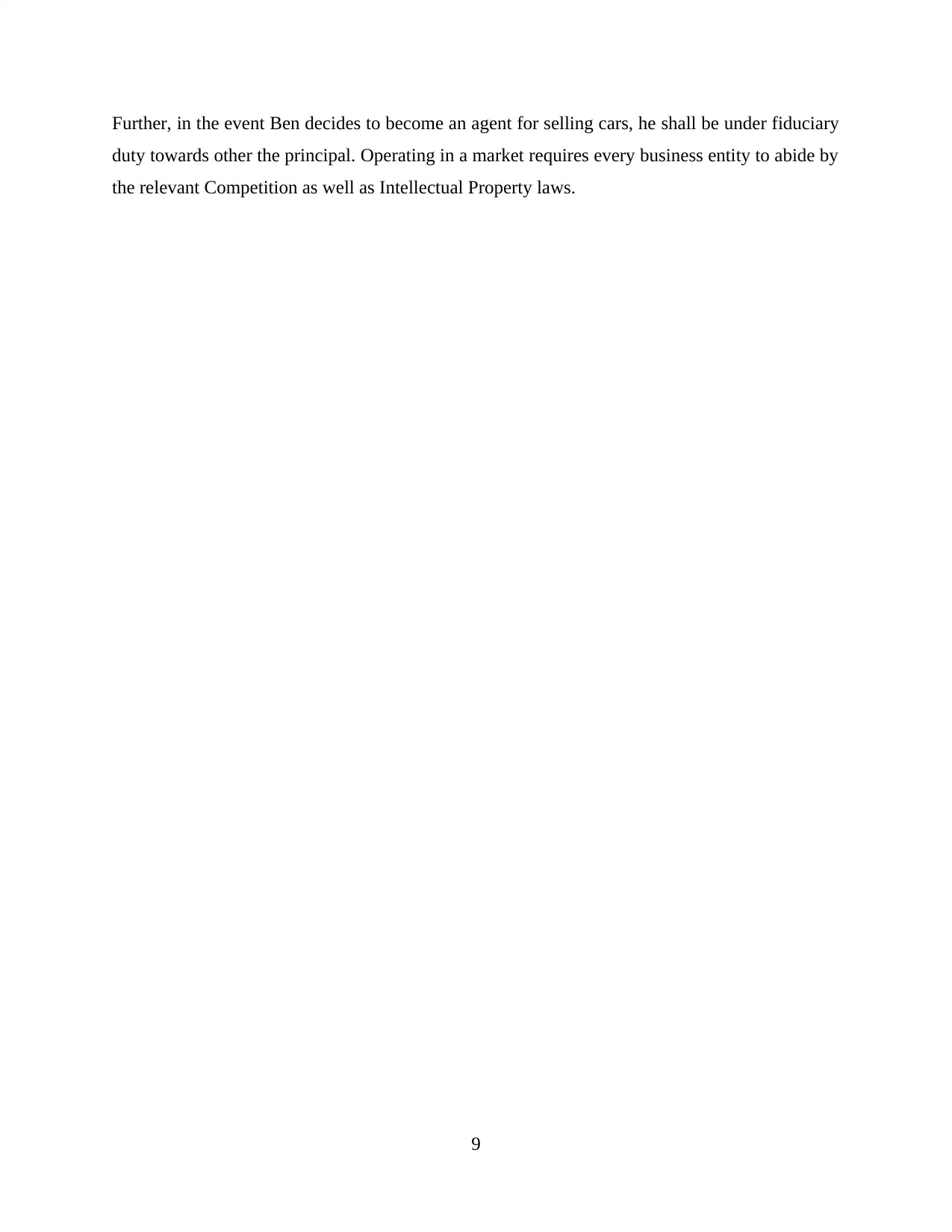
Further, in the event Ben decides to become an agent for selling cars, he shall be under fiduciary
duty towards other the principal. Operating in a market requires every business entity to abide by
the relevant Competition as well as Intellectual Property laws.
9
duty towards other the principal. Operating in a market requires every business entity to abide by
the relevant Competition as well as Intellectual Property laws.
9
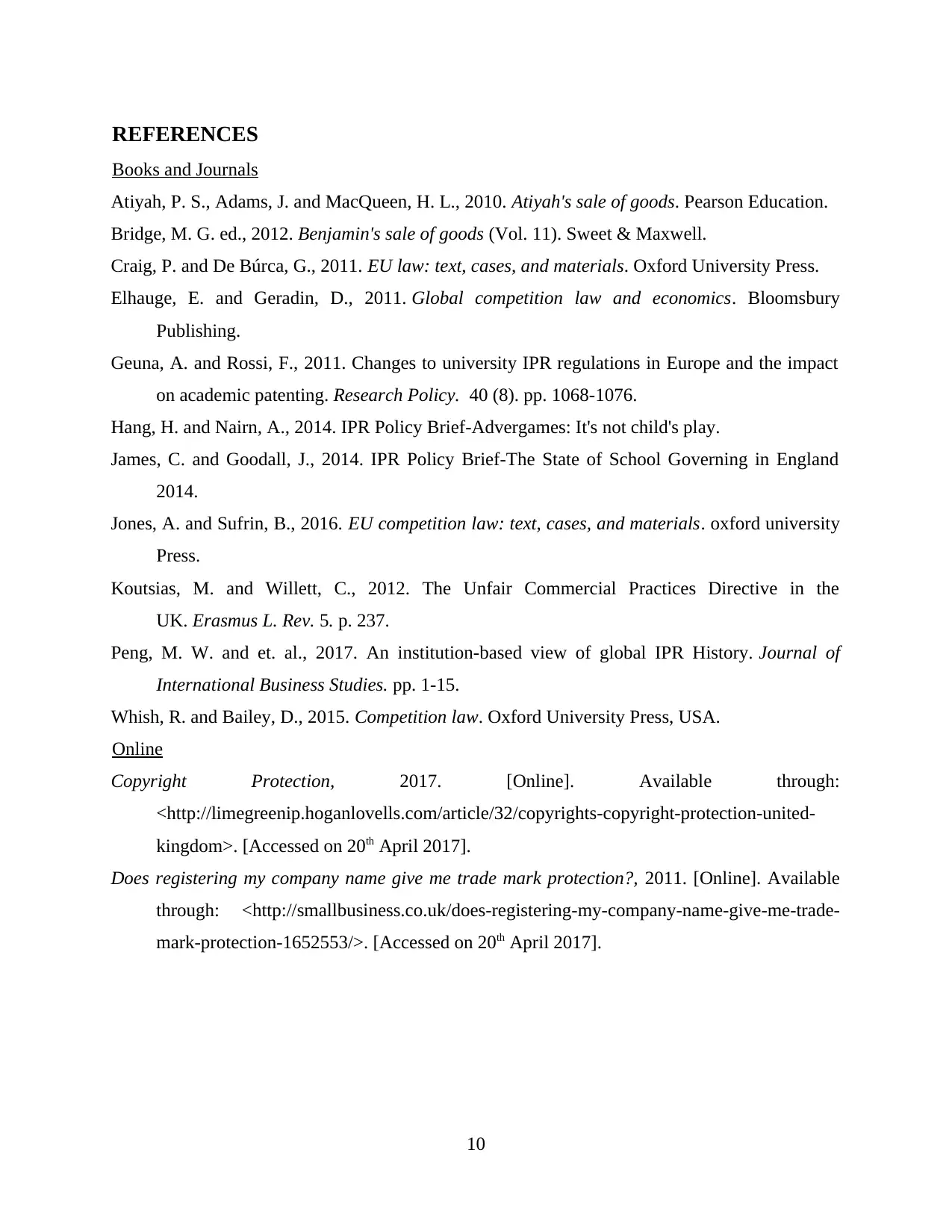
REFERENCES
Books and Journals
Atiyah, P. S., Adams, J. and MacQueen, H. L., 2010. Atiyah's sale of goods. Pearson Education.
Bridge, M. G. ed., 2012. Benjamin's sale of goods (Vol. 11). Sweet & Maxwell.
Craig, P. and De Búrca, G., 2011. EU law: text, cases, and materials. Oxford University Press.
Elhauge, E. and Geradin, D., 2011. Global competition law and economics. Bloomsbury
Publishing.
Geuna, A. and Rossi, F., 2011. Changes to university IPR regulations in Europe and the impact
on academic patenting. Research Policy. 40 (8). pp. 1068-1076.
Hang, H. and Nairn, A., 2014. IPR Policy Brief-Advergames: It's not child's play.
James, C. and Goodall, J., 2014. IPR Policy Brief-The State of School Governing in England
2014.
Jones, A. and Sufrin, B., 2016. EU competition law: text, cases, and materials. oxford university
Press.
Koutsias, M. and Willett, C., 2012. The Unfair Commercial Practices Directive in the
UK. Erasmus L. Rev. 5. p. 237.
Peng, M. W. and et. al., 2017. An institution-based view of global IPR History. Journal of
International Business Studies. pp. 1-15.
Whish, R. and Bailey, D., 2015. Competition law. Oxford University Press, USA.
Online
Copyright Protection, 2017. [Online]. Available through:
<http://limegreenip.hoganlovells.com/article/32/copyrights-copyright-protection-united-
kingdom>. [Accessed on 20th April 2017].
Does registering my company name give me trade mark protection?, 2011. [Online]. Available
through: <http://smallbusiness.co.uk/does-registering-my-company-name-give-me-trade-
mark-protection-1652553/>. [Accessed on 20th April 2017].
10
Books and Journals
Atiyah, P. S., Adams, J. and MacQueen, H. L., 2010. Atiyah's sale of goods. Pearson Education.
Bridge, M. G. ed., 2012. Benjamin's sale of goods (Vol. 11). Sweet & Maxwell.
Craig, P. and De Búrca, G., 2011. EU law: text, cases, and materials. Oxford University Press.
Elhauge, E. and Geradin, D., 2011. Global competition law and economics. Bloomsbury
Publishing.
Geuna, A. and Rossi, F., 2011. Changes to university IPR regulations in Europe and the impact
on academic patenting. Research Policy. 40 (8). pp. 1068-1076.
Hang, H. and Nairn, A., 2014. IPR Policy Brief-Advergames: It's not child's play.
James, C. and Goodall, J., 2014. IPR Policy Brief-The State of School Governing in England
2014.
Jones, A. and Sufrin, B., 2016. EU competition law: text, cases, and materials. oxford university
Press.
Koutsias, M. and Willett, C., 2012. The Unfair Commercial Practices Directive in the
UK. Erasmus L. Rev. 5. p. 237.
Peng, M. W. and et. al., 2017. An institution-based view of global IPR History. Journal of
International Business Studies. pp. 1-15.
Whish, R. and Bailey, D., 2015. Competition law. Oxford University Press, USA.
Online
Copyright Protection, 2017. [Online]. Available through:
<http://limegreenip.hoganlovells.com/article/32/copyrights-copyright-protection-united-
kingdom>. [Accessed on 20th April 2017].
Does registering my company name give me trade mark protection?, 2011. [Online]. Available
through: <http://smallbusiness.co.uk/does-registering-my-company-name-give-me-trade-
mark-protection-1652553/>. [Accessed on 20th April 2017].
10
⊘ This is a preview!⊘
Do you want full access?
Subscribe today to unlock all pages.

Trusted by 1+ million students worldwide
1 out of 12
Related Documents
Your All-in-One AI-Powered Toolkit for Academic Success.
+13062052269
info@desklib.com
Available 24*7 on WhatsApp / Email
![[object Object]](/_next/static/media/star-bottom.7253800d.svg)
Unlock your academic potential
Copyright © 2020–2025 A2Z Services. All Rights Reserved. Developed and managed by ZUCOL.





